
Chenopodium album is a fast-growing weedy annual plant in the genus Chenopodium. Though cultivated in some regions, the plant is elsewhere considered a weed. Common names include lamb's quarters, melde, goosefoot, wild spinach and fat-hen, though the latter two are also applied to other species of the genus Chenopodium, for which reason it is often distinguished as white goosefoot. Chenopodium album is extensively cultivated and consumed in Northern India, Nepal, and Pakistan as a food crop known as bathua.

Eriocoma hymenoides is a cool-season, perennial bunchgrass with narrow, rolled leaf blades. It is native to western North America east of the Cascades from British Columbia and Alberta south to southern California, northeastern Mexico, and Texas.

Chenopodium is a genus of numerous species of perennial or annual herbaceous flowering plants known as the goosefoot, which occur almost anywhere in the world. It is placed in the family Amaranthaceae in the APG II system; older classification systems, notably the widely used Cronquist system, separate it and its relatives as Chenopodiaceae, but this leaves the rest of the Amaranthaceae polyphyletic. However, among the Amaranthaceae, the genus Chenopodium is the namesake member of the subfamily Chenopodioideae.
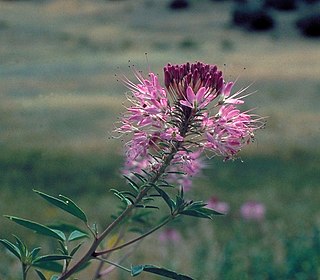
Cleome serrulata, commonly known as Rocky Mountain beeplant/beeweed, stinking-clover, bee spider-flower, skunk weed, Navajo spinach, and guaco, is a species of annual plant in the genus Cleome. Many species of insects are attracted to it, especially bees, which helps in the pollination of nearby plants. It is native to southern Canada and the western and central United States. The plant has often been used for food, to make dyes for paint, and as a treatment in traditional medicine.

Amaranthus blitoides, commonly called mat amaranth, prostrate pigweed, procumbent pigweed, prostrate amaranth, or matweed, is a glabrous annual plants species. It usually grows up to 0.6 m, though it may grow up to 1 m. It flowers in the summer to fall.

Lithospermum incisum is a species of flowering plant in the borage family known by several common names, including fringed puccoon, narrowleaf stoneseed, fringed gromwell, narrowleaf puccoon, and plains stoneseed. It is native to much of central Canada and the United States, where it is known from many types of habitat, but particularly piñon-juniper woodland. It is a hairy perennial herb growing from a narrow brown to black taproot and woody caudex. It produces a cluster of stems up to about 30 centimeters long. The stems are lined with narrow, pointed leaves up to 6 centimeters long. The slender, trumpet-shaped flowers are pale to bright yellow or gold, and may approach 4 centimeters long. The corolla face is 1 to 2 centimeters wide, its lobes sometimes ruffled. The smaller cleistogamous (closed) flowers are the main producers of seed.
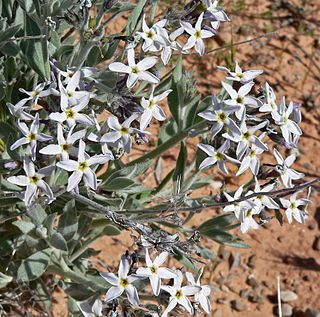
Amsonia tomentosa is a species of flowering plant native to the southwestern United States and northern Mexico (Chihuahua). Its common names include woolly bluestar and gray amsonia.

Cycloloma is a monotypic genus which contains the sole species Cycloloma atriplicifolium, which is known by the common names winged pigweed, tumble ringwing, plains tumbleweed, and tumble-weed. This plant is native to central North America, but it is spreading and has been occasionally reported in far-flung areas from California to Maine to the Canadian prairie. It is considered an introduced species outside of central North America. This is a bushy annual herb forming a rounded pale green clump which may exceed 0.5 m in height. It is very intricately branched, with toothed leaves occurring near the base. The spreading stems bear widely spaced flowers are small immature fruits fringed with a nearly transparent membranous wing. In autumn, the plant forms a tumbleweed. The fruit is a utricle about 2 millimeters long containing a single seed.
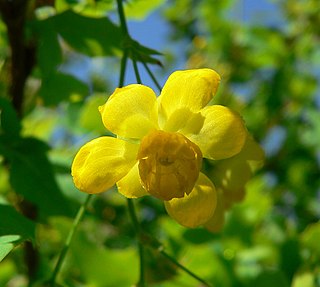
Mahonia fremontii is a species of barberry known by the common name Frémont's mahonia.

Chenopodium fremontii is a species of flowering plant in the family Amaranthaceae known by the common name Frémont's goosefoot. Both the species' specific epithet, and the common name derive from the 19th century western pioneer John C. Frémont.

Blitum nuttallianum, is a species of flowering plant in the amaranth family known by the common names povertyweed and Nuttall's povertyweed. It is native to North America, where it is widespread and common from Alaska to Mexico to New England. It can be found in many types of habitat, including disturbed areas, often favoring wet places. It is a fleshy annual herb producing two or more erect, reddish, hairless stems up to about 40 centimeters tall. The thick lance-shaped or arrowhead-shaped leaves are up to 4 centimeters in length. Clusters of several rounded flowers each appear in the leaf axils and yield small fruits about 2 millimeters wide.

Orobanche fasciculata is a species of broomrape known by the common name clustered broomrape. It is native to much of western and central North America from Alaska to northern Mexico to the Great Lakes region, where it grows in many types of habitat. It is a parasite growing attached to the roots of other plants, usually members of the Asteraceae such as Artemisia; and other genera such as Eriodictyon and Eriogonum. This plant produces one or more stems from a bulbous root, growing erect to a maximum of about 20 centimeters in height. The stems, leaves and five-lobed flowers are covered by sticky hairs. As a parasite taking its nutrients from a host plant, it lacks chlorophyll as well as a water-storage system. It is variable in color, often yellowish or purple. The inflorescence is a raceme of up to 20 flowers, each on a pedicel up to 15 centimetres long. Each flower has a calyx of hairy triangular sepals and a tubular corolla 1.5–3 cm long. The flower is yellowish or purplish in color.

Phoradendron juniperinum is a species of flowering plant in the sandalwood family known by the common name juniper mistletoe. It is native to the southwestern United States and northern Mexico, where it grows in various types of woodland habitat. It has been reported from California, Nevada, Arizona, New Mexico, Oregon, Utah, Texas, Chihuahua and Sonora.

Yucca glauca is a species of perennial evergreen plant, adapted to xeric (dry) growth conditions. It is also known as small soapweed, soapweed yucca, Spanish bayonet, and Great Plains yucca.

Pectis papposa is a species of flowering plant in the family Asteraceae. It is native to North America, where it occurs in the southwestern United States as far east as Texas, and in northern Mexico. Common names include cinchweed, common chinchweed, many-bristle chinchweed, and many-bristle fetid-marigold.

Lycium pallidum is a species of flowering plant in the nightshade family known by the common names pale wolfberry and pale desert-thorn. It is native to northern Mexico and the southwestern United States. In Mexico it can be found in Sonora, Chihuahua, Zacatecas, and San Luis Potosi. In the United States it occurs from California to Texas and as far north as Utah and Colorado.
This is a list of plants and how they are used in Zuni culture.
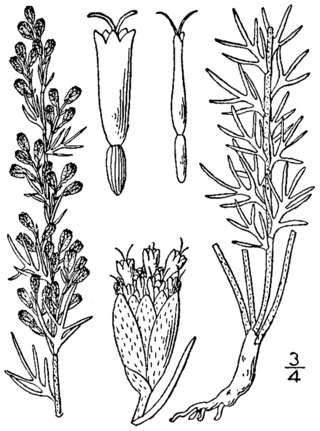
Artemisia carruthii, common name Carruth's sagewort or Carruth wormwood, is a North American species of shrubs in the daisy family native to much of south-central and southwestern United States. There are reports of a few naturalized populations in Missouri, the Great Lakes Region, and Rhode Island. It is also native to the States of Chihuahua and Sonora in northern Mexico.
Atriplex powellii, or Powell's saltweed, is a plant found in the United States and Canada.
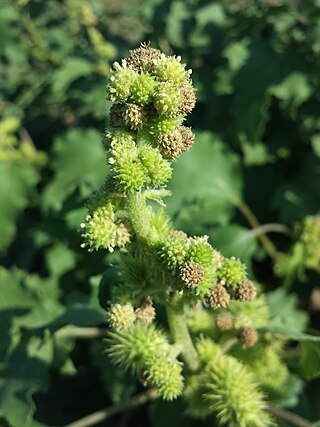
Xanthium orientale is a species of annual plant of the daisy family Asteraceae.



















